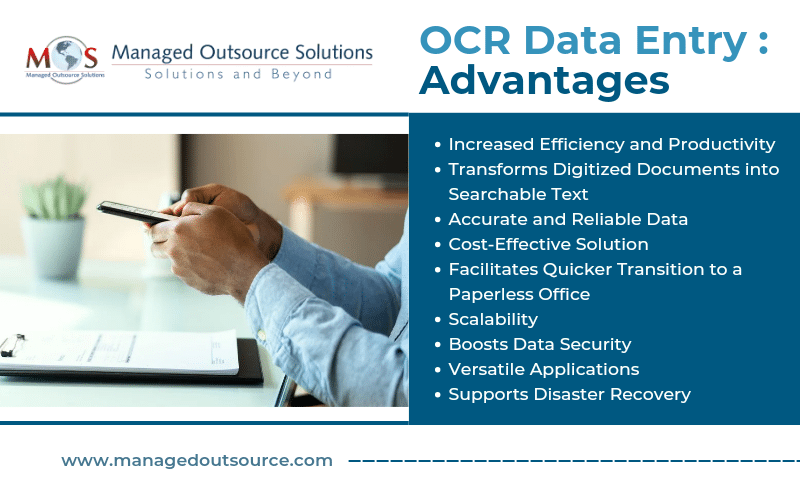Business workflows in industries such as banking, healthcare, legal, and logistics involve large volumes of paperwork that take a lot of time to process. This has fuelled the demand for data entry outsourcing in these sectors. However, manual data entry can be slow, tedious and error-prone. OCR data entry uses automated data extraction to quickly convert images of text into a machine-readable format. OCR reduces the time spent on manual data entry, making it an ideal option for quickly converting large volumes of documents into digital format.
OCR transforms scanned documents into editable digital text using AI algorithms. The process involves various steps: image capture, preprocessing, text detection, character recognition, postprocessing, and output.
By automating data entry and text extraction processes, OCR offers a way to streamline workflows, improve data management and promote informed decision-making. As industries embrace automation and data analytics, OCR has emerged as an essential tool to gain a competitive edge in the digital transformation journey.
Advantages of OCR Data Entry
Increased Efficiency and Productivity
OCR automates data entry and quickly digitizes large volumes of documents. It eliminating the manual effort needed to sort paper documents and provides information in well-structured format. OCR saves time and effort and ensures efficient data entry.
By enabling quicker data retrieval, OCR helps businesses boost productivity. By saving the time and effort required to access and search documents for relevant data, OCR-based data entry allows employees to focus on core activities, increasing productivity.
Transforms Digitized Documents into Searchable Text
OCR makes digitized documents completely text searchable, saving time and effort needed to find key information. For example, consider a researcher searching physical newspapers in a library to find articles with information on “local events” or “historical figures”. Manually sifting through each newspaper can take hours or even days. Utilizing OCR transforms the process. OCR software scans each newspaper page to create digital images and converts the text into a machine-readable format. The researcher can now simply type keywords (e.g., “local events”) into a search bar and the system retrieves the relevant articles in seconds from the database.
Accurate and Reliable Data
When it comes to manual data entry, errors are a major challenge. Automating data entry using OCR improves efficiency and results in better data quality by reducing human errors associated with manual entry. OCR processes and extracts data in real-time, and minimizes risk of data loss and inaccurate or outdated data.
Cost-effective Solution
Compared to hiring humans to perform data entry, validation and processing, OCR data entry is a cost-effective solution. With OCR, these tasks, regardless of volume, can be completed quickly without manual intervention. Digitizing documents also cuts down costs of copying, printing, and shipping manual documents.
Facilitates quicker Transition to a Paperless Office
Relying on paper documents for contracts, invoices, and reports clutters desks and filing cabinets. Searching for a specific document involves manual sorting through piles of paper, leading to lost time. By offering an efficient way for converting paper documents into electronic format, OCR ensures information is stored in servers, eliminating voluminous paper files.
Scalability
One of the biggest advantages of OCR-based data entry is that it is highly scalable. OCR technology can scan and convert thousands of documents into digital text simultaneously, extracting relevant data quickly and accurately. As requirements increase, organizations can easily scale up their OCR capacity without hiring additional staff. This makes it easy for sectors like ecommerce to adapt to seasonal spikes in data (like holiday sales) without the logistical challenges of scaling human resources.
Boosts Data Security
OCR technology supports data security and privacy compliance. By ensuring paper documents are stored in digital formats, OCR data entry eliminates loss or destruction of information due to moisture, pests, and fire, Furthermore, digitized documents enable end-to-end data encryption, ensuring the extracted information is safe from hacking, malware attacks, and cybercrime. Most data-based OCR platforms are designed to be compatible with regulations such as GDPR and HIPAA, and other stringent privacy laws.
Versatile
The versatility of OCR in automated data entry allows it to handle various types of input and output formats. It works with different types of documents and produces files in different formats. Input formats include handwritten forms, printed texts, scanned files and images. The various output formats OCR can produce include.DOC, .DOCX, .XLS, .XLSX, .TXT, searchable .JPEG, .PNG and .TIFF.
Disaster Recovery
Storing data digitally in secure servers or distributed systems enhances maintenance and protection, providing significant disaster recovery benefits. In emergencies, such as fires or natural disasters, digitized data can be swiftly retrieved, ensuring seamless business continuity even under challenging circumstances.
Outsource Data Entry – Ensure Efficiency, Save Time and Money
Adopting OCR technology positions organizations to thrive in a data-driven world. OCR-based data entry services offer a transformative solution for businesses seeking efficiency and accuracy in managing their data. By automating the extraction of information from various sources—whether printed documents, handwritten forms, or images—OCR significantly reduces manual labor and the potential for errors. Partnering with an efficient data entry outsourcing company will ensure the use of the latest technologies and skilled manpower, optimizing productivity and ensuring long-term success.





